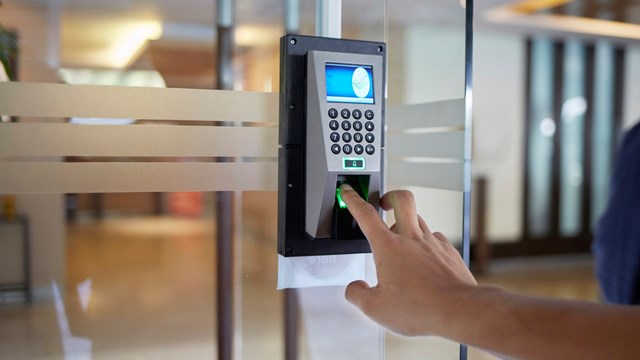The days when an apartment building's 'security system' consisted of a tricky front door lock and the landlord's ill-tempered dog are long past. Today, security measures range from old-style deadbolts to high-tech biometric screening equipment, with a lot of technology in between that includes both electronic and human components. For association board members and others living in co-op or condo buildings, understanding the functions and necessities of these security components is essential to having a safe community. Any resident should know how these various measures interlock to form a web of protection for them and their property.
But how should a residential co-op or condo building pinpoint its ideal level of security? Such an inquiry starts with determining the criteria the building’s management should take into account when considering a security installation or upgrade. Particularly in these sometimes stressful economic times, cost often is the most important factor for a board to consider when determining its community’s security needs.
Sometimes, the absolute necessity of a building’s leadership to provide for the safety of the residents must supersede cost. Because failing to provide adequate security for a building could be the basis of a lawsuit if a major crime is committed or a person is harmed, adequate security is about dollars and cents as much as it is about life and limb. Lawsuits against a building alleging inadequate security could be time-consuming, and also expensive to all of the community’s residents.
Due to such potentially costly threats, it is crucial for a board to conduct a thorough evaluation of the building’s security needs at least every few years, residential security experts say. For many residential structures, this evaluation begins at a building’s annual meeting.
Costly Inaction
The legal fallout for a building whose management fails to provide a minimum level of security can be quite serious. In addition to being subjected to expensive and time-consuming lawsuits, a building’s management might feel the need to immediately upgrade aspects of the building’s security system as a preventative measure. Doing renovations in such an on-the-fly manner can be the costliest way to upgrade, since competitive bidding often falls by the wayside during these crisis moments. Ideally, a building’s management will have assessed the security needs of the community before any serious crimes happen, and will be prepared.
Providing a safe atmosphere for residents is an obligation of the building’s management, many court cases have established. But the idea of “adequate” security for a building is something of a moving target—depending upon the neighborhood, or even on the block in which the building is located, or the day, month, or time of year, what could be deemed as adequate security at one moment might be seen as lacking later. In some buildings, a courtyard or lobby area could quickly become a camping spot for vagrants, or as an impromptu shop for brazen street-level drug dealers, for example.
In considering a building’s security system and needs, management should assess the history of the neighborhood, by checking police records and by polling residents regarding problems in the public areas of the building, and finding the places where security should be tightened up, says Jordan Lubitz, owner of Bronx-based Jordan Intercom & Mailbox Service Co. Inc. “It’s important to remind people that it’s not impolite to not hold the door open for someone you don’t know—they could have no business there. I think people tend to be too polite,” Lubitz says.
A building’s issues regarding access and control of parts of the security system could be as particular as the group of people living in the place. Some communities are filled with residents who don’t want to know much about the security system, as long as it works. In other communities in which there are many retirees, streaming video footage of images from the security cameras can be accessed by residents of individual units, via their television sets. The management of some buildings finds it necessary to have a security guard, while others do not, or feel the residents can’t support the extra cost of more paid employees.
All residential buildings have some types of security. Often, a building has a few security layers that amount to a thick blanket of mechanical, electronic and people-based measures to keep out the bad guys and keep the peace on the street around the building. Sometimes, a building’s management deems it necessary to have security guards in force to ward off unfriendly non-residents. But security guards can be considered too costly for some smaller buildings, though, because cost always is one of the first factors a building’s management team considers when evaluating its security needs.
Even with cost as a crucial element of a building’s security plan, the safety of the residents of the building must be of the utmost importance to management. That is why even some smaller buildings sometimes need to pay for security measures that some residents in the building might find to be excessive.
Manning the Gates
As with the potential sale price of a co-op or condo, location is a key factor in determining the level of security needed for the community. The neighborhood in which the structure is situated, or even the street along which it sits, could have an effect on the level of security needed, says Mark Lerner, PhD., president of Manhattan’s EPIC Security Corp., which provides uniformed security guards for communities.
All buildings have some system of door locks, and many still use the old lock-and-key system.
Many buildings have a closed circuit television system, with a modern DVR recording system attached to it. The device allows management and staff to monitor lobbies and other more public areas of the building, to ensure that no one is gaining access to the building’s property when they should not. More often than not, though, the device is used merely to record what’s happening in those areas, and the recording can be accessed later if a crime has been committed.
Many of the newer CCTV systems have wireless cameras that can be moved around, depending upon the need for tighter security in another part of the building. For example, a building resident might go away for several months and leave the apartment to the use of his children, who have loud parties or may be involved in illicit activity. After receiving complaints about such a scenario, the building’s management could hide a camera in the hallway outside the unit, to monitor the comings and goings of those who visit and live in the apartment.
This sort of snooping might seem not quite neighborly but it is not illegal. Since the hall is a public area that must be secured for all of the residents, management can easily justify taping activity there. Despite such measures, many criminals actually ignore the cameras and commit crimes in front of them, experts say.
“Be advised that CCTV is good for solving crimes but it is not good as a deterrent,” Lerner says. “For a deterrent, you need personnel. The more uniformed personnel you have, the greater the deterrent will be.”
When thinking about a building’s security system and possible upgrades to it, management must define what their goals are for security. Is the goal to secure your tenants? Is it to keep out unwanted strangers and prevent forced entries? These goals are a good place to start, and fall in line with requirements of New York’s Local Law 76, which mandates that exit doors must be clearly marked and easy to use—and not having things such as a slide bolt that a person might be unaware of, especially in the event of a fire. These doors should have panic bars, as well as a dead latches, which are locks that are spring-loaded and do not require electrical power to work.
While some buildings have doors with locking systems that are run by electricity, they are technically not allowed by law and more importantly, they are dangerous. During a power outage, such doors don’t work properly and can be accessed by anyone on the street.
“An electromagnetic lock by itself is not allowable by law because it doesn’t have that latching [mechanism],” says Mark Berger, president of Securitech Group Inc., in Maspeth. “The $2,000 fine a building could get for being in violation stinks, but the big cost could be lawsuits resulting from a crime committed because the building wasn’t properly secured.”
Buildings are permitted to use a magnetic lock legally provided it’s part of a system that also has latching which is not dependent upon electricity.
When assessing a building’s security, management should first ensure that the building entrance is secure. Next, they should look at the outer perimeter doors, such as side doors, gates from alleys and other entrances, to make sure they are continuously secured. Then management should assume that every visitor to the building is a potential problem, and they should ensure that visitors are doing what they say their purpose for being there is. This can be assessed by monitoring the building’s CCTV system.
Management also should make sure that side doors are rigged with an alarm that sounds, to prevent their use in any event but an emergency. Finally, management should train building personnel and residents to be polite but vigilant. “Only let people in that you know,” Berger says.
For some buildings, a minimum level of security could be an intercom system at the front door, and an electronic access system coupled with a low-tech latch type lock on the door. For larger buildings, adequate security would include a security guard monitoring the building’s entrance.
When it comes to potential court cases involving allegations of improper security in a residential building, many precedents have been set regarding what is considered a minimum level of security, says Edward Katta, vice president of sales for Bay Ridge Security in Brooklyn. “The most important factors are do the doors work, and is there an intercom system in place,” he says.
Jonathan Barnes is a freelance writer and a regular contributor to The Cooperator and other publications.







2 Comments
Leave a Comment